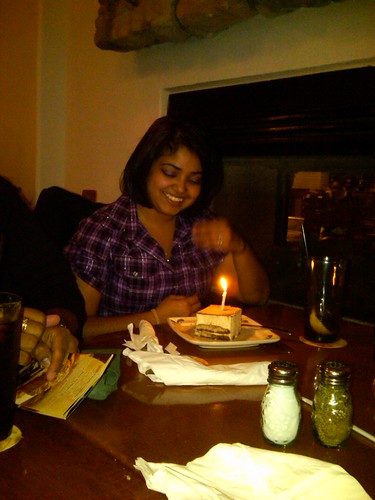How would I even begin to describe what I saw on October 14th. Perhaps I was dreaming and a bunch of people were just going completely crazy right before my eyes. Or perhaps I was cursed by some evil spirit who forced me sit there and watch ninety minutes of what I would call…torture!
When I went into the theater, I was super excited because I’ve been to the Brooklyn Academy of Music a few times before to see ballet performances and I absolutely loved it there. However, when I heard about this dance performance I didn’t really expect a whimsical and pretty ballet, but I did expect something entertaining. As I sat in my seat, I couldn’t help but take pictures of the amazing theater, which I fall in love with every time I’m there, but I was quickly scolded for just trying to take a picture for my photo journal :[ I saw in my seat, got comfortable, took out my bottle of water, flipped through my BAMbill and I was ready for an awesome experience–flashy dancers, beautiful costumes, amazing choreography, hip music, a storyline–I just couldn’t wait. But instead I received the complete and total opposite.
When the lights dimmed, I saw a chair with a spotlight on it. I thought that the dancers would come and start spinning chairs and crazy acts but instead, out comes Ralph Lemon with a small set of papers, and the screen lowers. “A film?! Are you serious…where the heck is the dancing? I could’ve stayed home if it was just a movie!” I thought to myself. After thirty minutes of watching a video that made absolutely no sense to me whatsoever, but I do admit that Lemon had a very soothing voice, the lights dim once more and I’m ready for some action.
Then the dancers came out in really crappy, bright, stretchy, cheap-material costumes that look like they took about two seconds to put together and start dancing like the crazy people on the video that I had just seen. That moment set off a lightbulb in my head, Ralph Lemon said that he made his dancers dance like that for three minutes and he wondered what would happen if he made them do it for thirty minutes. Foreshadowing? I think so. Those thirty minutes felt like forever. I didn’t understand what they were doing at all and at times, it began to be funny watching them. I did notice that there were some structured dance moves for example Okwui (I might have gotten the spelling wrong, actually I’m pretty sure I did) was doing a broken down version of a pirouette in the corner of the stage while another man was flipping in the air (Ten times!!!). These dance moves all seemed very familiar, but it was like they were messing them up on purpose.
I waited for thirty minutes, or thirty hours, and then a woman started to cry backstage. I thought to myself then that the story Lemon was trying to convey was about his grief for his partner, but the crying wouldn’t stop. In fact, the crying went on for probably another thirty minutes to the point where it was driving me completely insane and I wanted to yell out to Okwui “Shut the **** up already!!!”
Luckily, just as I felt as if I had reached my breaking point, the crying stopped. When the crying stopped a few animals came out including an adorable dog, the bunny from the video in the first act, a cow, a walrus, and god knows what else. I felt like I was in a staring contest, but the silence was a plus for me after hearing minutes of wild, crazy crying. The animals were cute…and I don’t understand why they were even there in the first place, but the projections were incredible.
Ralph Lemon comes out once more but instead he is dancing with Okwui, a duet that I felt I understood a little more. I actually really enjoyed this part of the dance, believe it or not because I felt like it was a love story between the two of them, and to me that was beautiful.
I left the theater not knowing anything that had happened and I was just focused on going home. In the train, I decided to read the BAMbill once more to see if I’d understand what had happened the second time around, which actually made me even more confused than before. When I heard that a professor who was the dramaturge would be in to speak with us, I was super excited because I would finally understand what I saw.
When the professor walked in, she was actually really cool to talk to and I felt comfortable with telling her about how much I actually hated the performance even though she had worked on it for so long. After her discussion, I still didn’t completely understand the piece and I still don’t really understand it, but that’s the beauty of it…Ralph Lemon didn’t want us to understand it, he wanted to create something so mind-boggling that it’ll stay with us forever, and possibly haunt us.
I finally understood that it was the breakdown of the body’s normal everyday activities and movements and Lemon wanted something different. Perhaps he wanted to show his grief for his partner, or the connection of time periods, or That’s exactly what he gave us–something really different that probably only a few in the audience could actually relate to, but we all found one part, one thread of the entire “story” that we could relate to. After the class discussion, I learned to really appreciate this type of art because we had a chance to go behind the scenes and really dig deep into the artist’s mind which proved to be extremely helpful in understand the piece.
What seemed like a horrid experience for me, actually turned out to be an eye opener. Although I am a lover of spectacle, fancy costumes, and an amazing storyline, I’ve come to appreciate art that doesn’t have any of this, but yet still does in its very own way.
 NYTimes Arts
NYTimes Arts
















